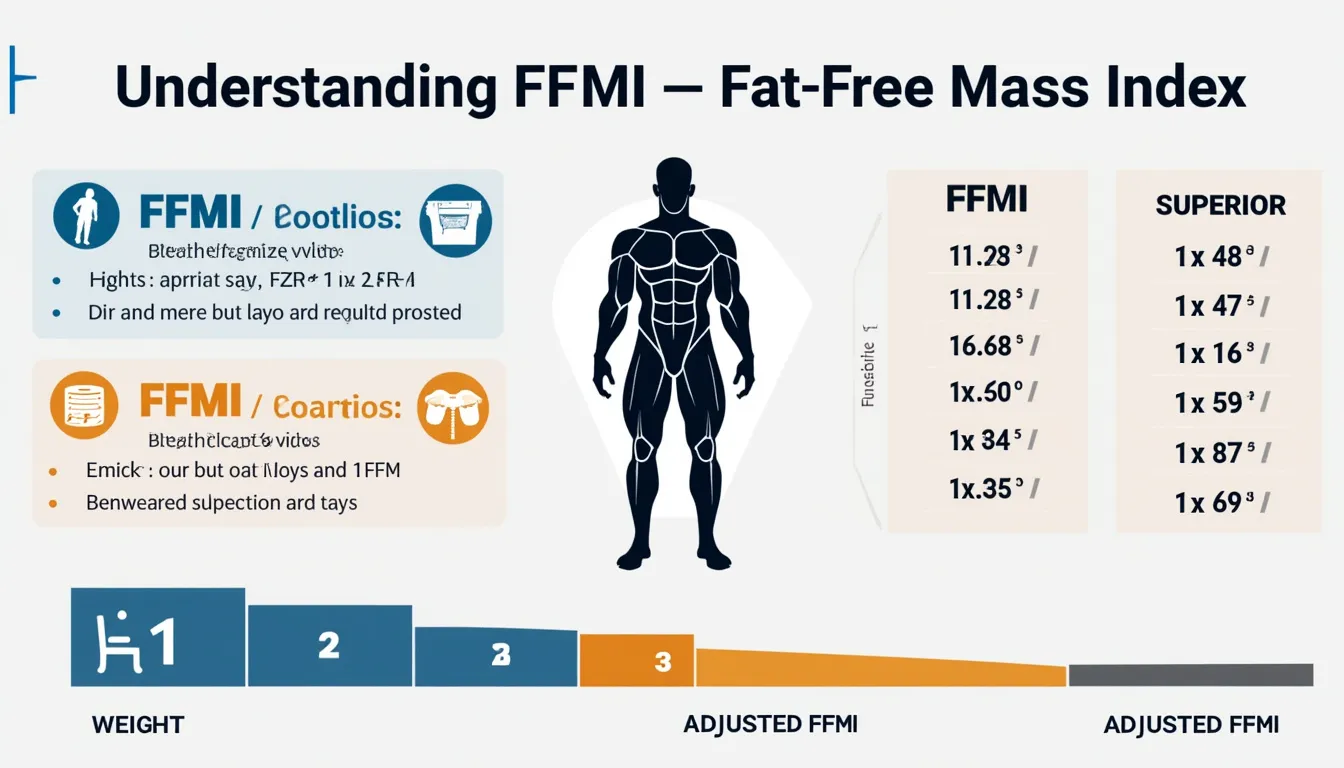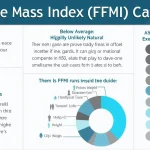Is this tool helpful?
How to Use the FFMI Calculator Effectively
The Fat-Free Mass Index (FFMI) Calculator is a powerful tool designed to help you assess your body composition and muscular development. To use this calculator effectively, follow these steps:
- Enter your weight: Input your current weight in the designated field. You can choose between kilograms (kg) or pounds (lbs) using the dropdown menu. For example, enter “70” if you weigh 70 kg or “154” if you weigh 154 lbs.
- Input your height: Provide your height in the appropriate field. Select either centimeters (cm) or feet (ft) from the dropdown menu. If you choose feet, an additional field for inches will appear. For instance, enter “170” for 170 cm or “5” for feet and “7” for inches if you’re 5’7″.
- Specify your body fat percentage: Enter your estimated body fat percentage in the designated field. This should be a number between 2 and 70. For example, input “15” if your body fat percentage is 15%.
- Click “Calculate FFMI”: Once you’ve entered all the required information, click the “Calculate FFMI” button to generate your results.
The calculator will then display your results, including your Fat-Free Mass, FFMI, Adjusted FFMI, and FFMI Category. Additionally, a chart will visualize your FFMI and Adjusted FFMI scores for easy comparison.
Understanding the Fat-Free Mass Index (FFMI): Definition, Purpose, and Benefits
The Fat-Free Mass Index (FFMI) is a sophisticated metric used to assess an individual’s muscle mass relative to their height, providing valuable insights into their body composition and muscular development. Unlike the Body Mass Index (BMI), which doesn’t differentiate between muscle and fat, the FFMI focuses specifically on lean body mass, making it an invaluable tool for athletes, bodybuilders, fitness enthusiasts, and health professionals.
Definition and Purpose
The FFMI is calculated using an individual’s weight, height, and body fat percentage. Its primary purpose is to provide a standardized measure of muscularity that accounts for differences in height. This allows for more accurate comparisons between individuals of varying statures and helps in assessing one’s muscular development relative to their frame size.
Key Benefits of Using the FFMI Calculator
- Accurate muscle mass assessment: By factoring in body fat percentage, the FFMI provides a more precise estimate of muscle mass compared to other metrics like BMI.
- Height-adjusted comparisons: The FFMI allows for fair comparisons between individuals of different heights, making it an excellent tool for tracking personal progress or comparing athletic potential.
- Goal setting and progress tracking: Athletes and fitness enthusiasts can use their FFMI score to set realistic muscle-building goals and monitor their progress over time.
- Identifying natural muscular potential: The FFMI can help individuals understand their natural muscular limits and set realistic expectations for their fitness journey.
- Nutritional and training guidance: FFMI scores can inform personalized nutrition and training plans, helping individuals optimize their approach to muscle building or maintenance.
The Science Behind FFMI: Formulas and Calculations
To fully appreciate the FFMI calculator, it’s essential to understand the underlying formulas and calculations. Let’s break down each component:
1. Calculating Fat-Free Mass (FFM)
The first step in determining FFMI is to calculate the Fat-Free Mass, which represents the total body weight minus the weight of body fat.
$$ \text{Fat-Free Mass (kg)} = \text{Body Weight (kg)} \times (1 – \text{Body Fat Percentage} / 100) $$2. Calculating FFMI
Once we have the Fat-Free Mass, we can calculate the FFMI by dividing it by the square of the height in meters.
$$ \text{FFMI} = \frac{\text{Fat-Free Mass (kg)}}{\text{Height (m)}^2} $$3. Calculating Adjusted FFMI
The Adjusted FFMI accounts for the fact that taller individuals tend to have higher FFMI values. It normalizes the FFMI to a standard height of 1.8 meters.
$$ \text{Adjusted FFMI} = \text{FFMI} + 6.1 \times (1.8 – \text{Height (m)}) $$Interpreting Your FFMI Results
After using the FFMI calculator, you’ll receive several key pieces of information. Here’s how to interpret them:
1. Fat-Free Mass (FFM)
This represents your total body weight minus your fat mass. It includes muscle, bones, organs, and other lean tissues. A higher FFM generally indicates more muscle mass.
2. FFMI
Your FFMI score provides a measure of your muscularity relative to your height. Here’s a general interpretation guide:
- Below 17: Below average muscle mass
- 17-19: Average muscle mass
- 19-21: Above average muscle mass
- 21-23: Excellent muscle mass
- Above 23: Superior muscle mass
3. Adjusted FFMI
The Adjusted FFMI normalizes your score to a height of 1.8 meters, allowing for fairer comparisons between individuals of different heights. Interpretation is similar to the standard FFMI.
4. FFMI Category
Based on your FFMI score, you’ll be placed into a category (e.g., “Above average,” “Excellent”) that provides a quick assessment of your muscular development relative to the general population.
Practical Applications of the FFMI Calculator
The FFMI calculator has numerous practical applications across various fields and personal fitness journeys. Let’s explore some key use cases:
1. Bodybuilding and Competitive Sports
For bodybuilders and athletes in weight-class sports, the FFMI calculator serves as a valuable tool for:
- Assessing current muscular development
- Setting realistic muscle-building goals
- Comparing muscular potential across different weight classes
- Tracking progress throughout training cycles
2. Personal Fitness Journey
Individuals on a personal fitness journey can benefit from the FFMI calculator by:
- Establishing a baseline for their muscular development
- Setting achievable muscle-building or body recomposition goals
- Monitoring progress over time to stay motivated
- Adjusting nutrition and training plans based on FFMI changes
3. Health and Wellness Assessment
Healthcare professionals and wellness coaches can utilize the FFMI calculator to:
- Assess overall health and fitness levels
- Identify potential muscle-wasting conditions
- Create personalized fitness and nutrition plans
- Monitor the effectiveness of strength training interventions
4. Research and Population Studies
Researchers in fields such as exercise science, nutrition, and public health can use FFMI data to:
- Study trends in muscular development across populations
- Investigate the effects of various training and nutrition protocols on muscle mass
- Analyze the relationship between FFMI and other health markers
Example Calculations: Putting FFMI into Practice
To better understand how the FFMI calculator works in real-world scenarios, let’s walk through a couple of example calculations:
Example 1: Male Athlete
Consider a male athlete with the following measurements:
- Weight: 85 kg
- Height: 180 cm (1.8 m)
- Body Fat Percentage: 12%
Step 1: Calculate Fat-Free Mass (FFM)
$$ \text{FFM} = 85 \times (1 – 0.12) = 74.8 \text{ kg} $$Step 2: Calculate FFMI
$$ \text{FFMI} = \frac{74.8}{1.8^2} = 23.09 $$Step 3: Calculate Adjusted FFMI
$$ \text{Adjusted FFMI} = 23.09 + 6.1 \times (1.8 – 1.8) = 23.09 $$In this case, the athlete’s FFMI of 23.09 falls into the “Superior” category, indicating excellent muscular development.
Example 2: Female Fitness Enthusiast
Now, let’s consider a female fitness enthusiast:
- Weight: 60 kg
- Height: 165 cm (1.65 m)
- Body Fat Percentage: 20%
Step 1: Calculate Fat-Free Mass (FFM)
$$ \text{FFM} = 60 \times (1 – 0.20) = 48 \text{ kg} $$Step 2: Calculate FFMI
$$ \text{FFMI} = \frac{48}{1.65^2} = 17.63 $$Step 3: Calculate Adjusted FFMI
$$ \text{Adjusted FFMI} = 17.63 + 6.1 \times (1.8 – 1.65) = 18.54 $$This individual’s FFMI of 17.63 (or Adjusted FFMI of 18.54) falls into the “Average” to “Above Average” range, indicating a good foundation of muscle mass with potential for further development.
Frequently Asked Questions (FAQ)
1. What is a good FFMI score?
A “good” FFMI score depends on various factors, including age, gender, and fitness goals. Generally, scores between 19-21 are considered above average, 21-23 excellent, and above 23 superior. However, it’s important to remember that these are general guidelines and individual circumstances may vary.
2. Can women use the FFMI calculator?
Yes, women can absolutely use the FFMI calculator. However, it’s important to note that women typically have lower FFMI scores than men due to physiological differences in muscle mass potential. A “good” FFMI score for women may be lower than for men.
3. How often should I calculate my FFMI?
For those actively working on changing their body composition, calculating FFMI every 4-6 weeks can be beneficial. This timeframe allows for noticeable changes in muscle mass and body fat percentage. For maintenance purposes, every 3-6 months is generally sufficient.
4. Does FFMI account for bone density?
While FFMI doesn’t directly measure bone density, it does include bone mass as part of the fat-free mass calculation. However, for a more accurate assessment of bone health, specific bone density scans (DEXA) are recommended.
5. Can FFMI be used to detect steroid use?
While extremely high FFMI scores (typically above 25) have been associated with potential steroid use in some studies, FFMI alone is not a definitive indicator of steroid use. Many factors, including genetics, training history, and nutrition, can influence FFMI scores.
6. How does FFMI differ from BMI?
While both FFMI and BMI use height and weight in their calculations, FFMI also incorporates body fat percentage. This allows FFMI to distinguish between muscle mass and fat mass, providing a more accurate assessment of muscular development. BMI, on the other hand, doesn’t differentiate between muscle and fat, making it less useful for athletes or muscular individuals.
7. Can I use FFMI to set muscle-building goals?
Yes, FFMI can be an excellent tool for setting realistic muscle-building goals. By understanding your current FFMI and how it compares to average and elite levels, you can set achievable targets for muscle growth. Remember to consider factors like your body type, genetics, and training history when setting goals.
8. How accurate is the FFMI calculator?
The accuracy of the FFMI calculator depends largely on the accuracy of the inputs, particularly the body fat percentage. For best results, use a reliable method to measure body fat percentage, such as DEXA scans, hydrostatic weighing, or professional skinfold measurements. Home methods like bioelectrical impedance scales can provide estimates but may be less accurate.
9. Can FFMI be used for children or adolescents?
FFMI was primarily developed and validated for adults. Its use in children and adolescents may not provide accurate or meaningful results due to the significant changes in body composition that occur during growth and development. For younger individuals, other growth and development metrics are typically more appropriate.
10. How does FFMI relate to overall health?
While FFMI is primarily a measure of muscularity, maintaining a healthy amount of muscle mass is associated with numerous health benefits. These include improved metabolic health, better insulin sensitivity, stronger bones, and enhanced functional capacity as we age. However, FFMI should be considered alongside other health markers for a comprehensive assessment of overall health.
By understanding and regularly using the FFMI calculator, you can gain valuable insights into your body composition, set realistic fitness goals, and track your progress effectively. Whether you’re an athlete, fitness enthusiast, or health professional, the FFMI calculator serves as a powerful tool in your health and fitness toolkit.
Important Disclaimer
The calculations, results, and content provided by our tools are not guaranteed to be accurate, complete, or reliable. Users are responsible for verifying and interpreting the results. Our content and tools may contain errors, biases, or inconsistencies. We reserve the right to save inputs and outputs from our tools for the purposes of error debugging, bias identification, and performance improvement. External companies providing AI models used in our tools may also save and process data in accordance with their own policies. By using our tools, you consent to this data collection and processing. We reserve the right to limit the usage of our tools based on current usability factors. By using our tools, you acknowledge that you have read, understood, and agreed to this disclaimer. You accept the inherent risks and limitations associated with the use of our tools and services.







